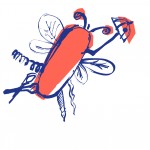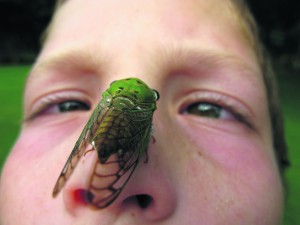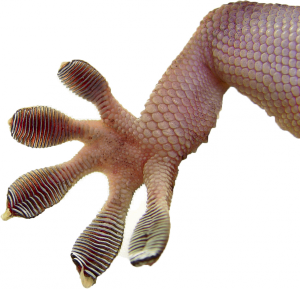SATURDAY, 7 MAY 2011
What abilities spring to mind when someone says ‘superhero’? The ability to fly? Walking on walls? Or an uncanny talent for surviving against the odds? Although Marvel Comics have been writing far-fetched tales about characters with superhuman powers for decades, evolution has turned fiction into reality and provided us with living, breathing and indeed flying proof that it got there first. So how do animals effortlessly achieve these things that humans merely dream of? And can we replicate them?A huge number of species across the animal kingdom can fly, from buzzing midges to lumbering vultures. But not all fliers are created equal. Most birds are only able to fly forwards, and are often relatively ungainly in the air, at least as compared to their smaller brethren: the insects. Insects are often capable of flying backwards or hovering on the spot, more like a helicopter than an aeroplane, and possess a fine control over flight that many birds lack. This allows them to land on your skin without detection, or even land on water. But how do they accomplish their feats of aerial acrobatics?
It turns out that insect flight is a complex phenomenon that is still poorly understood. According to some researchers, insects use at least three different mechanisms to increase their lift beyond that predicted by simple fluid mechanics. Firstly, their wings beat at a sharp angle to horizontal, creating an effect known in aviation as stalling. In aircraft, this is disastrous, causing huge loss of lift due to separation of the air flow from the wing and often causes the plane to crash. In insects however, the act of stalling creates a vortex (think miniature whirlwind) immediately above the leading edge of the wing, which provides a large lifting force, almost as if the insect is being sucked upwards. Secondly, as their wings travel through the air, they rotate. This rotation creates an additional down-current, which helps to keep them aloft in a manner analogous to a tennis ball with backspin. Finally, in addition to creating the leading edge vortex, any wing beat will inevitably create smaller trailing edge vortices behind the wing. These usually sap energy from the flier, but insects have adapted to sweep their wings back through the turbulent air, recapturing energy that would otherwise be lost. All these mechanisms contribute to a system far more innovative than our brute-force methods of getting into the air. One complex enough that we’re unlikely to be replicating it any time soon.
So perhaps insect-like flight is out of our reach, but walking on walls is a different story. Many species possess the ability to hang around obnoxiously on our ceilings and walls. Their methods may vary, but a couple of unifying themes emerge. Small insects, often flies, tend to take the rather obvious route of having sticky feet. They have tiny glands which slowly secrete an oily adhesive that literally glues them to the surface in question. Spiders have claws on their feet that hook into grooves too small for us to see (which, incidentally, is why they struggle to get out of very smooth containers such as baths and sinks). Yet clever as these two options are, the most ubiquitous and ingenious method is yet to come and proves that you don’t have to be an insect to have superhero qualities. This number is showcased by a friendly little creature: the gecko.
Gecko feet stick to surfaces using a well-known piece of chemistry called van der Waals forces. These forces are attractive, though very small, and exhibited by all atoms and molecules towards any other atoms or molecules via generation of instantaneous dipoles. This effect is in part responsible for many everyday phenomena, from being able to fill our cars with liquid petrol to the delightful experience of peeling chewing gum off our shoes. These forces vary inversely with distance, therefore they are very weak when the molecules are greater than a couple of nanometres apart. Most solid surfaces are too rough to see a significant interaction on this scale, even those we think of as being extremely smooth and flat such as glass. This is because only a tiny fraction of the surfaces are ‘touching’ closely enough to experience a force. The exception to the rule lies with extremely pliable solids, like the aforementioned chewing gum, which warp when sufficient force is applied and mould themselves to surfaces so closely that van der Waals forces come into play, sometimes with unpleasant consequences.
But humans can’t walk on walls just yet. The problem with sticky pliable substances is that they tend to stretch and deform when force is applied, and they still fail to have enough van der Waals interactions to bond anything remotely heavy to surfaces—imagine trying to stick yourself to the ceiling with Blu-Tack.
Once again, nature provides us with the answers. Rather than using a single flexible mass, evolution has bestowed some animals with structures known as setae on their feet. Much like a microscopic hairbrush, the setae form a mat of bristles each a great deal smaller than the hairs on your head. Individually, they deform very easily to allow good contact between the gecko’s foot and the ceiling, yet they are all relatively strong, so can be pulled off intact and re-used millions of times. As a result, a gecko’s foot is sticky, though it has no glue or claws; it just sticks. Now how about that for a superhero solution?
Aerial acrobatics and parkour-gone-mad are all very well; animals perform these feats every day. Yet nature’s superheroic tendencies do not end there. Throughout history, some organisms have survived incredibly harsh conditions, enduring weather that would rapidly kill any human without the support of technology. A personal favourite of mine are the insects found near the poles, such as the goldenrod gall moth caterpillar, which can survive astonishingly low temperatures, remaining mobile and unfrozen at temperatures as low as -50°C. Other animals and some plants do freeze, but in such a way that they enter a cryogenic state, and so survive to tell the tale some months later when the temperature increases.
Insects can avoid freezing at temperatures below zero by utilising the curious properties of ultra-pure water. The scientific principle dictates that although conventionally ‘pure’ water freezes at 0°C, water which is completely devoid of any impurities remains liquid down to around -40°C, defying all conventional wisdom and entering a ‘supercooled’ state. It appears that in ordinary water, ice crystals do not just form spontaneously; they always nucleate around some impurity, such as a speck of dirt. This impurity lowers the surface area of the budding crystal, reducing its energy and making it easier for it to form. In order for crystals to nucleate without their specks of dirt, they require a much greater driving force—and so a much lower temperature. Some insects stop feeding prior to the onset of freezing temperatures to avoid the food residues and mineral dust particles acting as nucleating agents. Other insects avoid freezing by producing antifreeze substances such as glycerol for their body fluids. Imagine if you could do that too.
Organisms using a cryogenic approach take the opposite view—rather than removing all nucleating agents, they make the effort to create highly efficient nucleating proteins. Traditionally, intra-organism ice has been considered lethal as water expands on freezing, and so the growing ice tends to rupture cell membranes. However, this only happens if the ice forms within the cell. Instead, animals such as the wood frog (Rana sylvatica) and many insects nucleate ice in the intercellular space, which lowers the amount of liquid water in the cells, making it harder for the remainder to freeze into large and damaging ice crystals. Ultimately, most of the water in the organism is locked into this extracellular ice, and so—when the temperature finally gets so cold that even the cells freeze—there is so little liquid water left that very few cells burst.
Although most of us regard insects as nuisances, the science which has made this class the most populous on the planet, outweighing all other species put together, is truly incredible. We should take the opportunity to learn from our miniature cousins and other superheroic organisms, and our efforts in mimicking nature will continue to enhance our technology. I don’t expect to see Superman whizz past my window any time soon—but perhaps Spider-Man isn’t quite so far-fetched. Maybe it’s time to stock up on some skin-tight outfits and a cape.
Mark Nicholson is a 3rd year undergraduate in the Department of Chemistry



